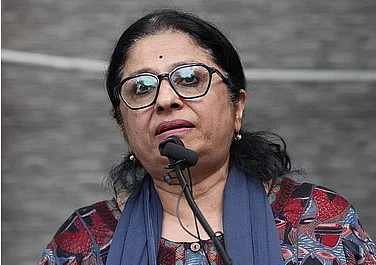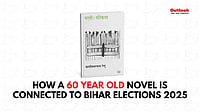There is a novel by Upendranath Ashk, Shahar Men Ghumta Aina, incidentally, translated into English by Daisy Rockwell as In a City a Mirror Wandering. I am constantly reminded of the novel after the announcement of the 2022 International Booker Prize. In the world of literature, the mirror of Hindi has been constantly moving for the past one hundred and fifty years. It has been introducing the best of national and international literature to Hindi readers. If I put it plainly, the important role Hindi always played has finally begun to get its recognition after nearly one hundred and fifty years. The world’s mirror has moved towards Hindi earlier as well but has halted for the first time. There is no hesitation in saying that it will usher in a new era of dialogue and bonding.
Relationships sustain only when they are carried on mutually. Hindi has made untiring efforts, without any grudge or complaint, to bring the languages of the world closer to the intellectual needs and literary taste of its society. But it was rarely carried out with the same readiness by other languages. This is not merely because of the lack of readiness or reach of the Hindi publishing industry, this is also due to a lack of healthy two-way dialogue and an ignorance, deliberate or unintentional, in other languages about the Hindi writing, which stands among the finest. The translation is possible only through mutual dialogue. The richer the dialogue between the writer-translator-editor-publisher, the easier would be the path to a good translation.

The Hindi sphere is hesitant and a trifle dry by nature, which has hindered its progress. For whatever reasons, Hindi has always shied away from proudly showcasing itself. Many Hindi works are being translated. There are many translators, and awards for translated works as well but little discussion on good translators and good translations. Hindi media barely reviews translated books and ignores translators as a whole. This could be due to the mentality of viewing translation as purely commercial or technical work. By ignoring the creative aspect of translations, we deprive ourselves of understanding the importance of translators.
Many gifted writers of Hindi have readily translated literature of other languages into Hindi and here is a great example. Shankar’s novel Chaurangi was published in Bengali in 1962, which established him as a writer and earned him great fame. To date, about 145 editions of the novel have been out in Bengali. The legendary fiction writer Rajkamal Chaudhary translated it into Hindi, which was published by Rajkamal Prakashan in 1964. Shankar is well-known because of this book in the Hindi sphere, but he received global fame when Arunava Sinha‘s English translation was published in 2007 --- 45 years after the original and 43 years after the Hindi translation. There are many writers in Indian languages whose books have been translated into Hindi before they’ve won the Sahitya Akademi or the Jnanpith award --- from U. R. Ananthamurthy, Girish Karnad, Bhalchandra Nemade to Damodar Mauzo. It’s also true for writers of international languages. Be it Mario Vargas Llosa or Olga Tokaczuk, their books had been translated into Hindi before they won the Nobel Prize. Plenty of such examples exist when several great books of the world have been translated into Hindi much before they gained traction or their writer received global acclaim.
But few languages are doing a similar task to Hindi. Not many languages show the readiness to embrace Hindi works, though some changes are apparent and there are signs of a two-way translation and dialogue. One hopes that this process will be accelerated after the International Booker Prize for Ret Samadhi.
Now that Hindi has a spotlight on it, we have to seriously reflect on our basic preparation. Everyone would like to connect with us and expect a better dialogue. We will have to showcase our literature better. We will have to open multiple channels of communication with translators and publishers of other languages. Ret Samadhi was written over a long period of seven years, such a marathon writing process requires endless patience. I remember that Geetanjali Shree was alert to every word and sentence. She was careful of every comma, semicolon, ellipses, and full stop --- how to use them, or whether to use them at all. The novel has a sentence of just a single word, or an entire context being described by a three-word sentence which was published as a sub-section. How would each section start, how would it end, and which motif to be included in which section --- serious deliberations took place on each issue before a final decision was taken. From the first cover designed by Ghulam Mohammad Sheikh and then the cover of a later edition from a painting by Daisy Rockwell, this journey has been full of intense conversations and transformations. Geetanjali Shree breaks the mould with a rare restlessness in her writing, she had the same edginess with her book’s production. The more she observes every object with a keen gaze, the more it keeps her creative mind active. To understand such a complex behaviour pattern of a creative persona and to accommodate her requirements is the duty of a publisher. It then takes the best writing to the world.

Big honours and prizes in any language do not come quickly, but books are not written or published for a prize. Why do we want to read the literature of our regional languages and world languages in our own language? To be a part of their grief, struggles, loves, and understand their sensitivity and sensibilities and thereby disentangle the knots in our own lives. To understand their society, to seek succour, solace and strength in our trying times. The reason could be any, but literature brings us universal truths and takes us to people of various races and identities. Right now most countries of the world are undergoing a phase of restlessness. There has been an increase in aggression and violence in almost all societies of the world. History is being dug up and vengeful thoughts are gaining strength. In such times, a call for humanity is a universal demand. In India, Hindi-speaking states are undergoing a phase of tremendous restlessness, and society seems to remain on an aggressive path for at least the next 25 years. Till the time two generations are tired and the third learn a lesson from them and changes its path, this can remain the pattern. Sigh! It should not happen.
Just at this juncture, a climate for a new type of writing in the Hindi region has been created, as well as the demand for creative translations. The last century was about the dialogue of Hindi with other languages of the world. It is possible that this century can be about the languages of the world engaging in a dialogue with Hindi, with women’s writing being the prominent voice of this century. They have the raw ingredients of reality. They have the depth and the intensity of feeling. Whatever be their ethnic or religious identity, they all want to express themselves. Literature is not written for translation, but great translations hold enormous worth for literature. We need translations to take these Hindi voices to the world.
(Satyanand Nirupam is the Editorial Director of Rajkamal Prakashan, the publisher of Geetanjali Shree's Ret Samadhi.)
(Translated from the Hindi by Rumi Malik)





















